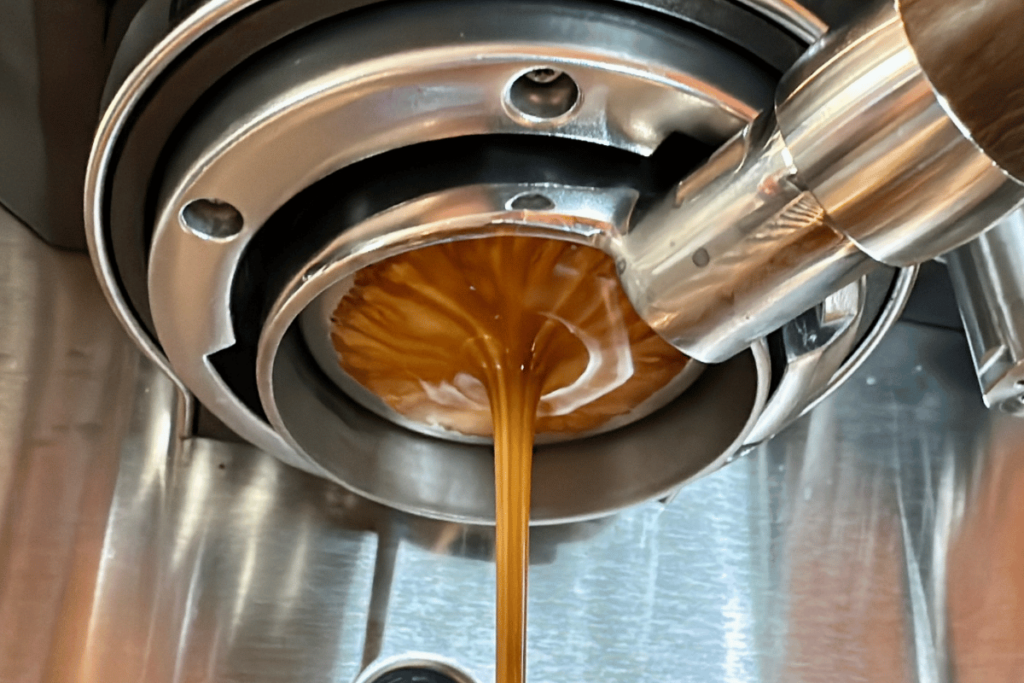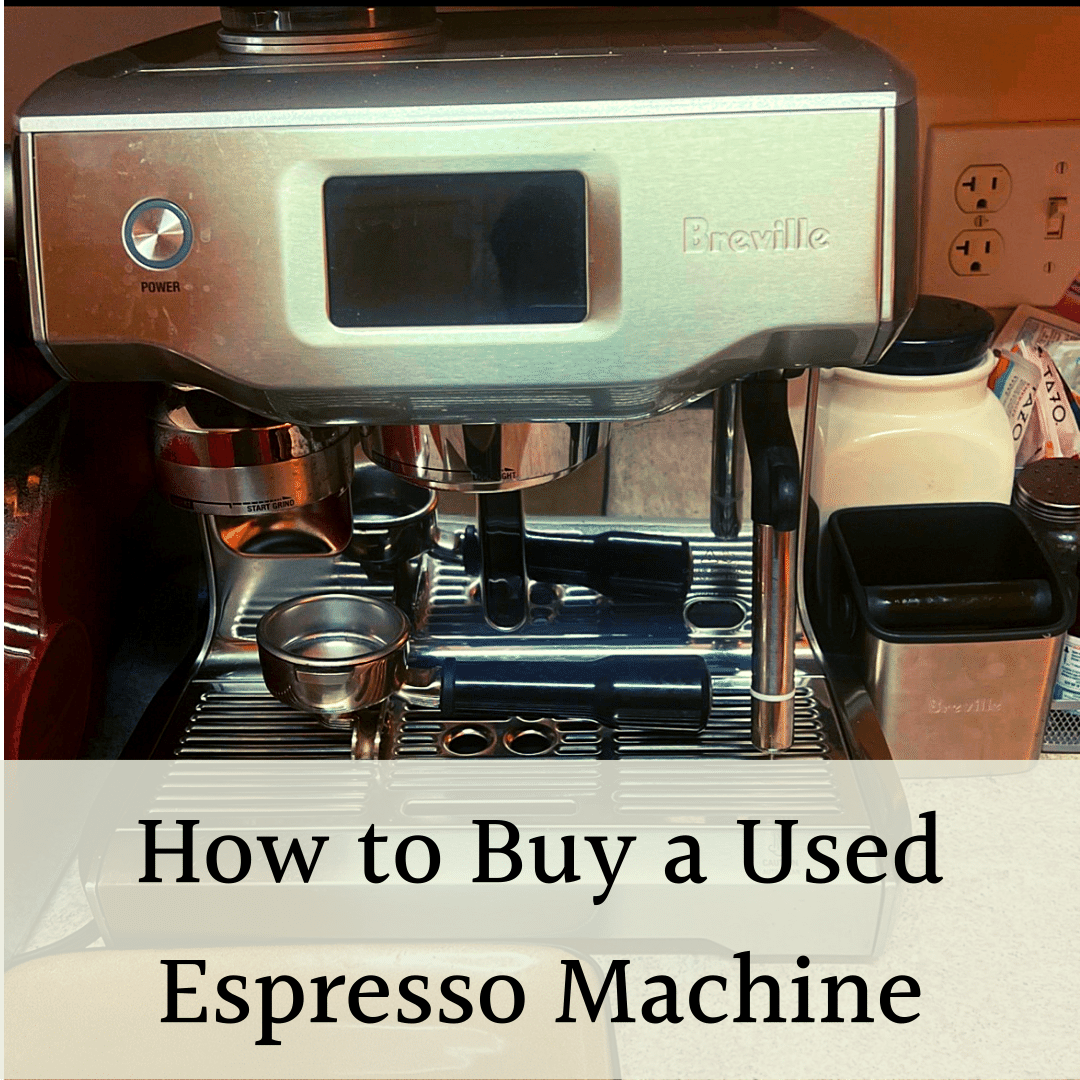
There are two kinds of people in this world: those who don’t give portafilters a second thought and espresso addicts who engage in a heated debate between the bottomless and the spouted portafilter.
The main difference is that the bottomless portafilter gives you a clear window into the extraction process, and it’s easy to clean and maintain. There is nothing under the portafilter obscuring your view, and barista trainers use them for educational purposes.
Spouted portafilters channel the flow of espresso in a steady stream. They’re more common in home espresso machines because they create less mess but are harder to clean, and they hide flaws in your puck prep.
Let’s get into the portafilter showdown, where bottomless and spouted will fight it out to see which is the better brewing tool.
What Is a Bottomless Portafilter?
Portafilters come in two broad categories: spouted and bottomless. The difference in these portafilters determines how easy it is to see your espresso with trade-offs in cleanliness and ease of use.

A bottomless portafilter has no spouts on the bottom (hence the name). It’s also called a “naked portafilter” because you can clearly see the underside of the basket. Without a basket, the bottomless portafilter looks like a metal ring with a handle. When you pour espresso, it flows through the puck in a straight, centered column of liquid that goes from the basket into the cup.
A bottomless portafilter is often more challenging to use for beginner baristas, but it can help improve the espresso quality and the coffee-making process. It highlights problems in your espresso technique by letting you observe the coffee extraction process. You can see the espresso as it forms and comes out of the filter, which helps you identify issues.
Meanwhile, most espresso machines come with a spouted portafilter, which has a solid bottom underneath the basket with one or two spouts that protrude from its bottom. The coffee flows through the basket and then out the spouts in your cup. This can be helpful if you want to split a double espresso between two cups since you can place one cup under each spout as the espresso is brewing.
How Does A Bottomless Portafilter Impact Espresso Taste?
A bottomless portafilter doesn’t directly impact espresso taste. Other factors affect your espresso taste, like grind size, dose, yield, and the espresso machine.
However, the bottomless portafilter has an indirect effect on the taste. That’s because a naked portafilter gives you an unobstructed view of how water and coffee transform into espresso, which acts as a learning tool to improve other factors that do affect the taste. When the flow of espresso is exposed, there is less guesswork as to what’s happening in your shot.
Ideally, your espresso will start dripping from three or four different places at the bottom of the basket before combining into a central, flowing column. You should have alternating dark and light espresso with a silky texture. You should not have liquid trying to flow from the basket sides or major color variations.
Overall, a naked portafilter is primarily useful in providing visual cues that will help you diagnose and correct extraction issues, such as channeling.
Ability to Diagnose Channeling
Channeling happens when the water finds a secondary path through the coffee puck. This happens because of a poor grind, uneven distribution of grind, or an uneven tamp. The result is uneven extraction. The parts of the puck that the coffee goes through get over-extracted, while the others that the water doesn’t reach are under-extracted. The result is a sour or bitter coffee taste.

A regular spouted portafilter hides these issues and makes it more difficult to diagnose the problem correctly, but a naked portafilter lets you observe the extraction process and easily identify channeling. Then, you can change your technique and adjust the grind size, tamping, etc., to see which of these may have caused the channeling.
Crema
The crema is aromatic foam on top of your espresso. Crema also doesn’t have a direct impact on espresso flavor, but it contributes to a richer mouthfeel and aroma that enhances the coffee flavor (remember, the majority of our taste comes from the sense of smell). Also, rich crema can be a sign of a well-made espresso.
Some baristas believe a bottomless portafilter creates a thicker crema with a richer taste compared to a regular portafilter. They say this happens because a bottomless portafilter creates an uninterrupted flow from the basket to the cup. It’s believed that a spouted portafilter causes some crema to stick to the spout, which means less crema in your shot. Also, if the spout is cold, it’ll cool the crema and sink into the cup faster.
However, there are a million things that have a more direct impact on espresso crema, like the freshness of the coffee beans and water pressure. If you’re not getting the crema you want from your espresso, it’s probably because of another factor besides the portafilter.
Overall, I found no significant difference between a bottomless and regular portafilter crema. As long as you have a good extraction technique and fresh beans, you should have good crema.

Aesthetic Benefits
Another benefit of a bottomless portafilter is the visual appeal. There’s something mesmerizing about watching a well-pulled shot develop. You can watch espresso as it starts to drip, turn into an even stream, and flow straight into your cup. It’s satisfying to see your hard work pay off.
Also, a naked portafilter is great for cafes with open espresso bars. It serves as a visual attraction and shows your coffee prep craftsmanship. It’s infinitely more Instagrammable than a regular portafilter, which means easy social media and marketing content.

Cleaning Benefits
Cleaning benefits are my favorite reason to use a bottomless portafilter because there’s no build-up of coffee and water in the bottom. For example, a Breville espresso machine comes with a 54 mm spouted portafilter that has plastic inside. This plastic piece makes it easy for water to get trapped in the portafilter. You have to dry it out, or you’ll have stale water and old coffee in your next shot.

On the other hand, bottomless portafilters don’t have any hidden or hard-to-reach areas. The basket is completely exposed, and there’s less surface for the buildup to cling to. You can knock out the used puck and rinse the bottomless portafilter underwater to remove leftover grounds. You’ll never have leftover, stale coffee contaminating your espresso shots.
A bottomless portafilter is also easy to disassemble for washing and deep cleaning. I’ve broken a nail or two pulling out the basket from a spouted portafilter, but you can easily knock it out of a bottomless portafilter to rinse it.
I easily prefer working with a bottomless portafilter when it comes to maintaining clean equipment and doing regular maintenance.
Espresso Spraying From A Bottomless Portafilter
One of the main drawbacks of a bottomless portafilter is spraying, which can happen during extraction. This is when small jets of espresso shoot out of the portafilter in random directions while brewing. Spraying is messy, but it’s usually another clue you should improve your extraction technique. You’ll only get spraying if the flow is too fast due to channeling or too coarse grind size.
Spraying will happen when you first use a bottomless portafilter, which is why they’re challenging for beginner baristas. It’s also why almost all entry-level espresso machines come with a spouted portafilter.
A messy example from my early espresso days:
To fix spraying, grind finer or use a WDT to even out the coffee bed so the water flows more evenly.
If changing your brewing technique doesn’t help with spraying, try using paper filters inside the portafilter, underneath the puck. A paper filter helps distribute the coffee more evenly, which reduces spraying. Moreover, a paper filter strains out heavy and bitter compounds, so you have a sweeter, cleaner espresso.

Should You Use A Bottomless Portafilter?
Yes, I recommend you use a bottomless portafilter. Bottomless portafilters are more hands-on than spouted ones, and they can help you learn about the science of espresso making and identity issues that affect espresso quality. Moreover, a naked portafilter lets you enjoy the visual aspect of pulling espresso and is easier to clean.
Overall, bottomless portafilters aren’t necessary, but it’s a valuable tool for espresso lovers who want to improve and perfect their technique (or just take some Instagrammable espresso shots).
Bottomless vs. Spouted Portafilter: Final Thoughts
My advice is to give bottomless portafilters a try. It’s another tool that can help you perfect your technique and make it easier to experiment with coffee grinding, tamping, distribution, and more. You may find a new ally in the espresso-making process.
If you’re just getting into the world of espresso, it can be overwhelming with all the espresso accessories available. To save you time (and money), we’ve reviewed the best accessories for a Breville espresso machine.




